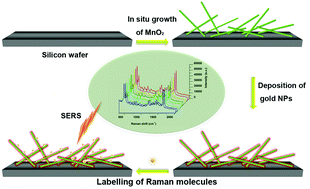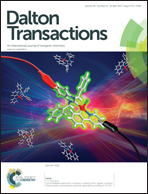In situ controlled sputtering deposition of gold nanoparticles on MnO2 nanorods as surface-enhanced Raman scattering substrates for molecular detection†
Abstract
Single-crystal tetragonal α-MnO2 nanorods with different amounts of gold nanoparticles (NPs) attached were successfully prepared by a facile sputtering deposition technique. Initially, the morphology and crystal structure of the bare α-MnO2 nanorods synthesized via a hydrothermal approach were investigated. Then, the amount of gold NPs at different sputtering times was analyzed. It was confirmed that the amount of the decorated gold NPs increased with the lengthening of the sputtering time until they completely covered the α-MnO2 nanorods. Theoretical calculation results indicated the advantages of the composite structure by showing the enhanced electromagnetic fields around both the bare α-MnO2 nanorods and the gold NP decorated ones. The surface-enhanced Raman scattering (SERS) efficiency of these nanocomposites was evaluated using methylene blue and 4-mercaptobenzoic acid as Raman probe molecules. It was found that the SERS intensity of the substrates strongly depended on the degree of aggregation of the gold NPs. Uniform SERS signals across the entire surface of these samples were obtained. Moreover, a typical chemical toxin, methyl parathion, was effectively detected over a broad concentration range from 1 × 10−3 to 100 ppm using the gold NP decorated α-MnO2 nanorods, suggesting this hybrid structure is highly valuable for further applications on the rapid detection of organic environmental pollutants.


 Please wait while we load your content...
Please wait while we load your content...